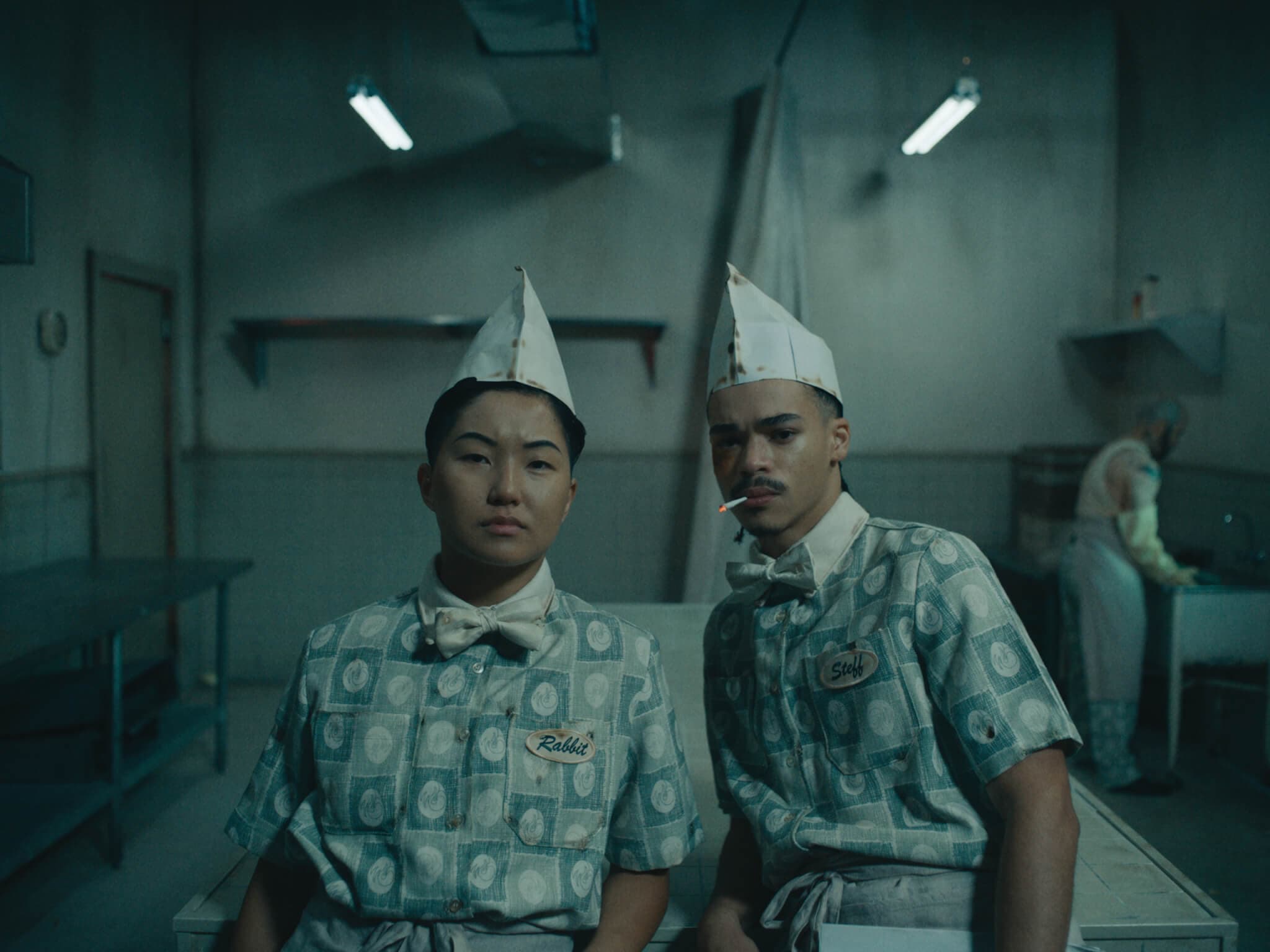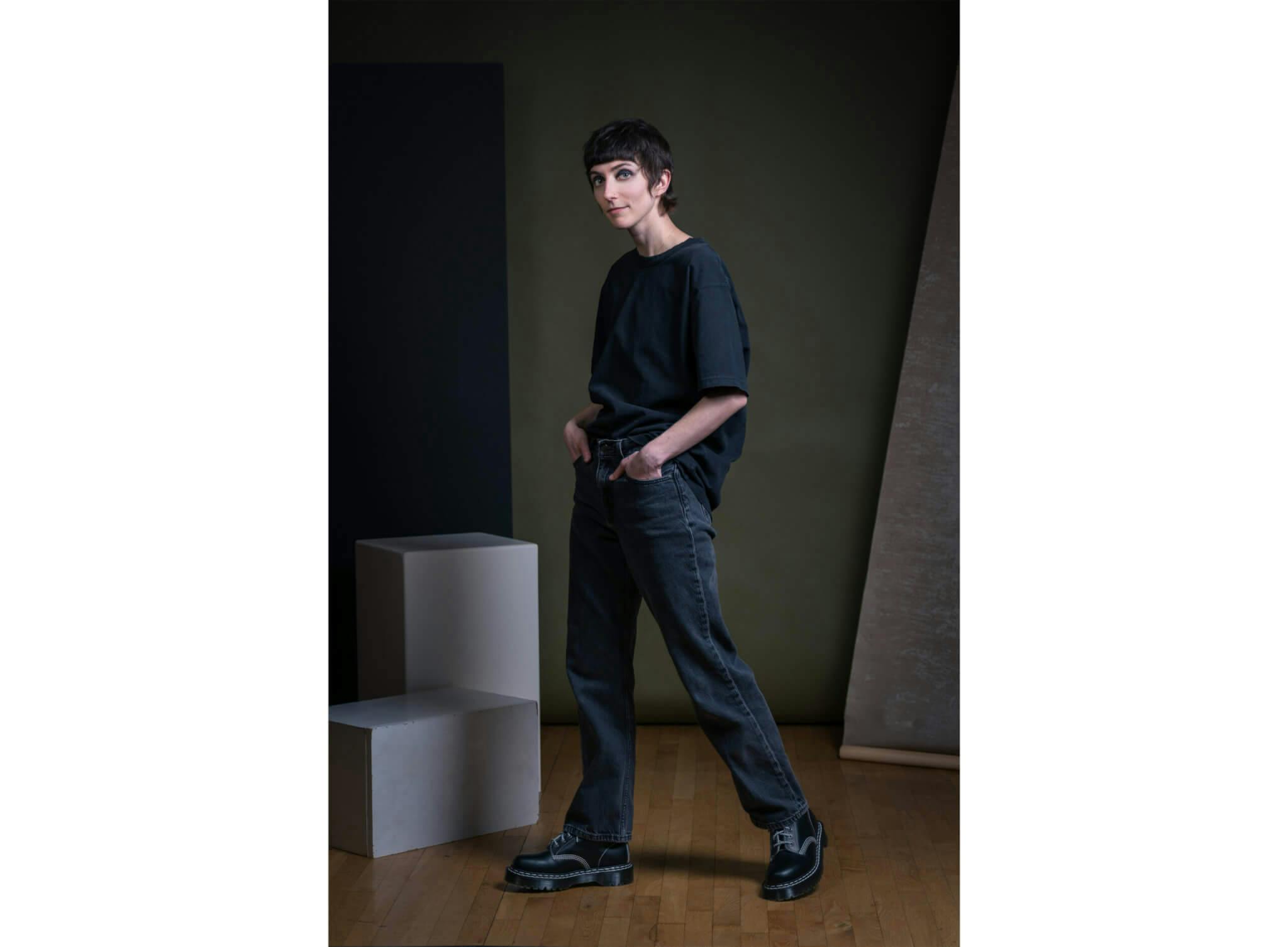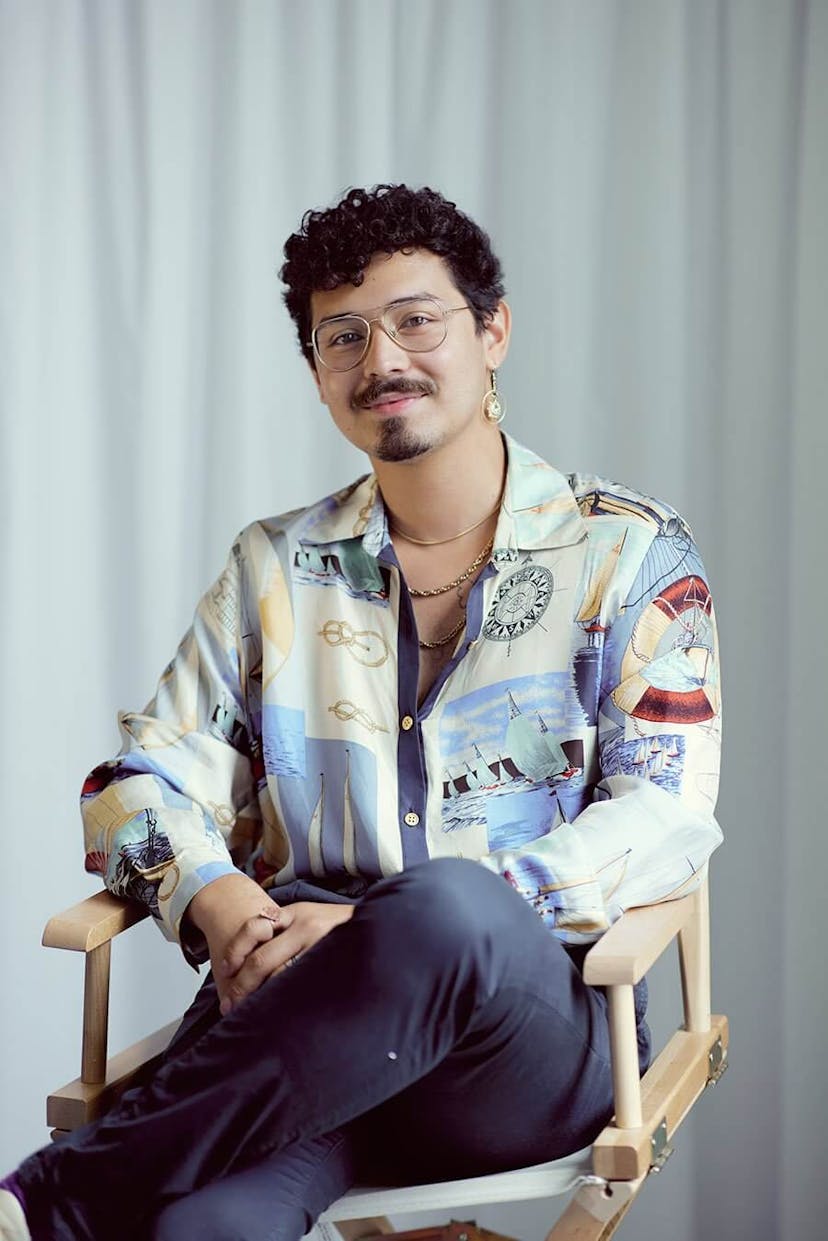When I first met time-based media artist Georden West in 2021, it was through a screen. Then the director of the Boston LGBTQIA+ Artist Alliance (BLAA), West dedicated themselves to bringing queer creatives together in the midst of the pandemic while simultaneously teaching at Emerson College and serving at Club Café. Around that same time, West was starting production of a feature-length film—a project larger in scope than anything they’d done previously. They’d come across Playland Café while researching legendary Boston drag queen Sylvia Sidney’s archive at The History Project, an independent community archive focused on preserving New England’s queer histories. Discovering that it was Boston’s oldest gay bar also came with the realization that there was little information on it anywhere—and in that absence, West found inspiration for an operatic, transdisciplinary, genre-resisting memoir of a place existing in queerness’s own ecstatic temporality: Playland.
Playland follows the ghosts of Playland Café’s inhabitants through one last night across time on the eve of its demolition in the late 1990s. Layering intimate moments and gestural performances in scenes set in 1943 through 1992, West is unconcerned with linear narratives or documentary truth, and instead invites viewers to speculate on the emotions, memories, labor, and relationships that make up the social fabric of queer spaces. West worked with an opera set designer to ensure that Playland created a fantastical space, allowing reality to sit on top of it rather than define it, and used archival footage and interviews throughout the film to honor any hints of truth in its narrative and establish the historical significance of the nearly forgotten Playland Café. Playland comes alive with an ensemble cast of queer actors, including drag icon Lady Bunny, Danielle Cooper, who acted in the TV series Pose, and cameos from Boston-based stars such as photographer OJ Slaughter. The film premiered at the 2023 Rotterdam Film Festival to sold-out screenings and has received critical acclaim for defying definition and expanding queer narratives through cinema.
I had the pleasure of watching the film and interviewing West ahead of its theatrical release. When West materialized on my Zoom screen for only the second time since our first virtual meeting, I was gleefully disoriented by the familiarity of their presence both then and now. It is that strange feeling of a transtemporal sense of community that West conjures in Playland and invites us to consider in their wider practice of making the invisible visible.
The following conversation has been edited and condensed.
Jasper A. Sanchez: Georden, I haven’t been able to stop thinking about time since watching Playland. The nonlinear, atemporal narrative of the film and your queering of the concept of time resonated with me. So I wanted to start big and inquire about your relationship with time.
Georden West: I think in regard to my relationship with time, the antenormative precedes the normative. When writing and editing the film, I was thinking a lot about this network of individuals as an entangled polyphonic chorus rather than pulling out the individual voices. Fred Moten talks a lot about this in his work—we’re not really fated to be individual; we’re the multitude. Entanglement like that is not just the goal, it already exists. Recognizing that has to be the goal.
I wanted to bring moments of spontaneous order to the film but also really indulge in the chaos, which is how time exists, at least for me. I went to a talk with the author of Gay Bar: Why We Went Out, Jeremy Atherton Lin. One thing he warned of was this idea of palimpsest and some of the problematics but also abundant opportunities in rewriting history over and over again. How do I provide a framework to explore these stories but also allow this entangled chaos to exist on top of this space? And so I think the place—the Playland Café—and the specificity of that location identity allowed me to go wild with time.

Lady Bunny as Sunday and Gatekeeper Adrian as Tex watch an archival clip of Boston Redevelopment Authority director Robert T. Kenney, who served under Mayor Kevin White from 1971–1977, on television as a cat purrs between them. Film still, Playland, 2023. Courtesy of Georden West.
JAS: I love that you mentioned thinking of place, not as a constraint, but as an invitation to think about the dimensions of time that have existed in that one place and the beauty of that interconnectedness and that chaos. Working as a public art curator myself, place as a concept comes up constantly. Conceptually, politically, and historically, we’re always encountering questions of who belongs, who owns, who’s been here, who’s here now, and what’s happened here. So I must ask, What brought you to the Playland Café? Why this place? Where did you learn about it, and what sparked your research?
GW: At MIT I came across a dissertation about the Combat Zone [the moniker given to down-town Boston’s adult entertainment district in the 1960s]. I was completely unaware of what down-town Boston, the Washington Street area, looked like until the nineties, when a huge development and renovation happened. [Many factors contrib-uted to the collapse of the Combat Zone—rising property values, the spread of AIDS, the closure of the Charlestown Navy Yard, and the introduction of the internet.] But it was the fact that that sort of architecture, the physical elements of a city, could completely erase a fringe subculture, not only from having some sort of visual representation, but also archivally.
So shifting through ephemera in order to figure out what was there and what traces remain, you’re relying a lot on secondhand or firsthand testimony. It’s interviews with people who had visited a bar! So I think this archival silence was something that demanded a speculative opening. How do we reimagine in the gaps of what’s been erased? You can only ever provide the contours of someone else’s existence or experience. And I think what we were aiming to do was not create something that we were portraying as reality, but allow the audience to coauthor this story with their experiences and their memories. It really is a memory palace in a lot of ways.
JAS: I was shocked to find out when I was doing some research that there were only a few newspaper articles with the Playland Café named, and it was difficult to find information online. So I’m curious: Where did you go to find more information?
GW: The History Project! The real MVPs of the archive space in Boston! It’s so nice as a commu-nity member to be able to walk into a space and feel welcome there, even as an amateur archivist and researcher. I’m abundantly grateful for them. Doing research there really opened up the possibil-ities that were ripe in the Playland Café. Even in the archive, the reviews of the Playland are like, “This is a place you would bring your enemy.” This is not the hip bar to take a colleague at the end of the day. But I was also reading between the lines of what does that mean, and who’s writing these things?
JAS: Who is the author of these narratives?
GW: Yeah. And what does it mean for a gender-variant community to find a gathering place? How is that authored in the archive? Who’s allowed to be preserved in that space? To me, what spoke volumes were the largely negative reviews about the safety of this place. When I hear that I’m like, what unwelcome people have become welcome?

Miranda Quinn as Rabbit and José Lapaz-Rodríguez as Steff appraise the audience while Mason Caminiti as Frankie washes dishes and whistles. Film still, Playland, 2023. Courtesy of Georden West.
JAS: During your research on the Playland Café, did you discover anything that really stuck with you? What have you learned from exploring this queer place from Boston’s past?
GW: That was one of the last places Chanelle Pickett was seen alive, whose court case was the first in which a trans panic defense was popularized. Thinking about Boston history as American history and the emergence of legislating against queer, trans, gender-variant bodies really does have a direct and fragile line back to this place. Getting to touch these violent but historically relevant moments that emerged from this place was really important to me. I think the Playland, to me, is not something that exists in the past. It is, in a lot of ways, a call to action to protect these brick-and-mortar gathering spaces that still exist.
JAS: Absolutely. The timeliness of Playland really struck me because, in 2020, Machine Nightclub and Ramrod were bulldozed. And if you go there now you’ll see luxury condos. But it’s also timely because very recently, this legendary venue named ManRay reopened in Central Square in Cambridge. Playland had me thinking about queer places and nightlife from the past and now, how they’re resurfacing—how a place like ManRay, even after being closed for twenty years, opened to a line around the block of patrons, old and new, saying things like, “I used to come here when I was in my twenties,” or “I’ve never been here before, but this place has a legacy of being a safe place for alternative and queer people.”
GW: Yeah, that’s something that working at Club Café taught me about what this film needed. You do have people who are coming in here bringing their memories with them, or mourning, or celebrating. And then you have this whole generation of new folks who are having their first gay bar experience. And I think dance and movement is so important and invaluable to placemaking and community making. Going back to Gay Bar’s conception of how we participate in a social body: it’s through touch and places where people move their bodies with one another. There’s something really invaluable there to our sense of self and this idea of an external world and our vast inferiority being mediated by skin.
JAS: Queer bodies are so historically policed. Public spaces where you can bring your body and be in your skin and not worry about being in contact with other folks and just experience touch at that kind of social scale—that’s special.
GW: It is special! And I think in this film, I wanted queerness to not even be part of the equation when people were engaging with one another. That is just already so established and so fluid. Especially all the back-of-house folks, who aren’t at all concerned about evaluating someone’s gender or sexuality. That was more fundamental to me: these placemakers and seeing, what labor are they doing? How are they engaging and in a social fabric with one another? And it is highly gestural. It’s highly based on touch and exchange rather than relying on semantics.

(from left to right) Miranda Quinn as Rabbit, José Lapaz-Rodríguez as Steff, Danielle Cooper as Lady, Constance Cooper as Viv, Sprat as Rosie, and Gatekeeper Adrian as Tex, paused in time as the sun sets on Playland. Film still, Playland, 2023. Courtesy of Georden West.
JAS: We’ve spoken a lot about the research behind Playland and your relationship with time but not about your wider practice as an artist. Your explorations as a time-based artist aren’t just limited to film—you’ve created multimedia installations and experiences grounded in the durational. So I wanted to ask if you could speak a little bit about where Playland fits into your overall practice as an artist.
GW: I would say the question that’s always at the center of what I’m working on is a relationship to time and how that plays out. So with Playland, the amorphous relationship to time in the film was a beautiful exploration for me as an artist to better situate the possibility of the queer moving image and what we’re demanding of it right now. How I can push not just what I’m depicting but the form it takes as well, in placing live action with dance, with archive, and more of a bricolage that evades any sort of genre description. There’s something inherently queer about being ungovernable and allowing the moving image to do that.
In the film, you’re also sitting with the characters as they’re engaged in pretty quotidian tasks that are profoundly mundane. Not just for them but for the audience as well, having to sit with someone and witness someone else’s labor. I think sometimes there’s such a disconnect between the experience we’re having and the labor that goes into providing that experience, allowing that labor to be erased. We never really see anyone on the dance floor in Playland; we only see the DJ. Who are the people who are really spending their lives in and making their livelihoods from the space? These people in the film are subjects who push back against any sort of commodification, where there’s no external semantic remarks in which we can define them or position them. They’re unfixed in that sort of way. And that makes me really excited. That has led to other projects about invisible ecologies. How can I surface the histories of a specific place? Or the entities that do occupy that place? I think we treat the idea of “the gallery” as the ultimate interior-away-from-the-outside-world “White Cube.” Like any other internal space and architecture, it’s fighting constantly to keep the outside out and the inside in. Creating pieces that test the line between those things—showing fringe communities existing in a place they were not welcome in—is something that speaks to my work’s interest in mapping geography and queering those forms in more meaningful time-based ways. //
Playland will have its North American Premiere at Tribeca Film Festival on June 9, 2023. Upcoming screenings include:
Tribeca Film Festival (New York, NY): 6/9, 6/10, 6/16
Provincetown International Film Festival (MA): 6/15, 6/17
Frameline Film Festival (San Francisco, CA): 6/22
Correction: the print version of this interview misheard the qualifier “French” subculture, which has been corrected to “fringe” subculture.




